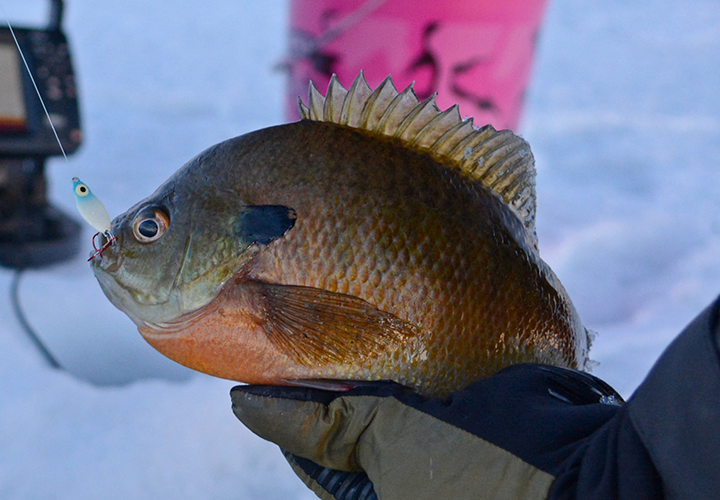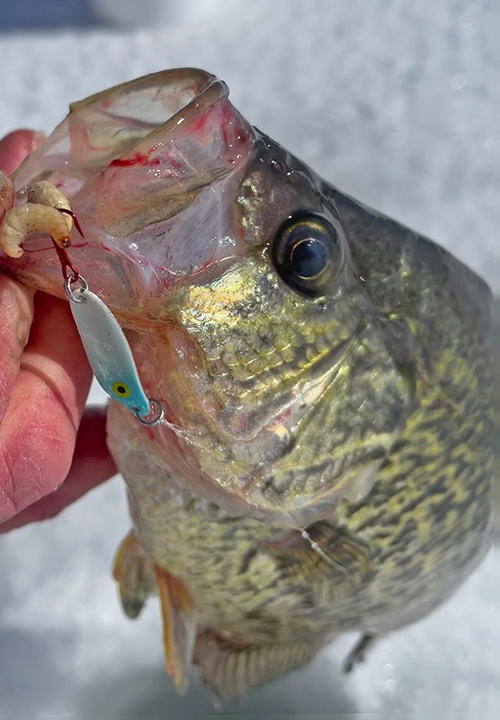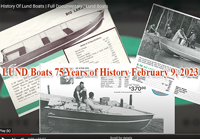
 Jeff Sundin February 10, 2023 "MN DNR Panfish Workgroup Where Do We Go From Here?"
Jeff Sundin February 10, 2023 "MN DNR Panfish Workgroup Where Do We Go From Here?"
 In this 45 second clip from the film “Hero”, Dustin Hoffman, playing the role of Bernie LaPlante, explains to his son, “the meaning of life”. Paraphrasing his explanation, LaPlante summarizes, that in life, “all there is, are layers of bulls..t”. Someplace along the line each one of us picks our layer of B.S. and from then on, this is what defines us. For the fish’s sake, I hope that’s not true, but we’ll get back to that later.
In this 45 second clip from the film “Hero”, Dustin Hoffman, playing the role of Bernie LaPlante, explains to his son, “the meaning of life”. Paraphrasing his explanation, LaPlante summarizes, that in life, “all there is, are layers of bulls..t”. Someplace along the line each one of us picks our layer of B.S. and from then on, this is what defines us. For the fish’s sake, I hope that’s not true, but we’ll get back to that later.
On Wednesday, the Minnesota DNR “Panfish Workgroup” convened for the first meeting of its newest term. The group is a blend of members returning for repeat terms, along with new members who have yet to serve on the panel. After introductions and a rundown of the group’s history, a progress report about the Quality Sunfish Initiative, implemented in 2021, was provided. The takeaway was that it’s still too soon to know how well sunfish will respond in all the QSI lakes. But based on successes in the smaller group of lakes with special regulations already in place, there is a sense of optimism.
With over 200 lakes now receiving special protection for sunfish, most of the effort will now go into studying and gathering statistics. There will be tweaking, adding a lake here and there to the program and most of these will be based on angler request. Progress reports, provided on an ongoing basis, were brought forward as a high-priority by certain group members. DNR Fisheries Staff were agreeable, so I’d anticipate having updates about the QSI from time to time.
With the heavy lifting about sunfish finished, the obvious question was “where do we go from here?” The answer, almost as obvious, was crappies. But unlike sunfish, figuring out what to do about “fixing” problems with crappie fishing lakes will be tricky, really tricky. Biologically, crappies are totally different from sunfish. Their spawning habits are different, their feeding habits are different and so are their preferred habitats. Many of the “fixes” that were both obvious and statistically provable for sunfish won’t work for crappies. What’s worse is that some fix-ups that could serve to improve crappie fishing are going to be extremely unpopular to anglers.
Understand, I am not speaking on behalf of the Panfish Workgroup, or on behalf of the DNR, I’m just your average citizen. But that said, I do have a lot of time on the water and from that, a lot of anecdotal evidence to support my “theories”. So, here’s what I think we’re on the verge of learning. #1, crappies are their own worst enemy and #2 anglers are their 2nd worst enemy.
 Why do I believe that? Because discussion about things that crappies need to be “protected” from led in 2 important, but predictable directions. First, the subject of forward-facing sonar, the technology that allows anglers to search for schools of fish horizontally instead of only looking straight down. Second, the practice of fishing for crappies in deep water and the subsequent detrimental effects of barotrauma caused by it.
Why do I believe that? Because discussion about things that crappies need to be “protected” from led in 2 important, but predictable directions. First, the subject of forward-facing sonar, the technology that allows anglers to search for schools of fish horizontally instead of only looking straight down. Second, the practice of fishing for crappies in deep water and the subsequent detrimental effects of barotrauma caused by it.
Discussion connecting the two issues spawned from an impromptu collaboration conducted recently between Lindner Media and MN DNR fisheries staff. Their goals were to locate crappies in deep water, capture them and keep them alive underwater in large holding nets. What they hoped to learn from that was how many of the fish survived after the trip topside from deep water.
Gathering the fish was easy, Mike Hehner said. “The fish were moving around, so we used the forward facing sonar to locate the schools as they swam. Once we saw them, we’d move over them, drill holes and catch as many as we could before they moved.” Within about an hour the team of biologists and anglers reported gathering over 50 crappies, a task that would typically have taken many hours using “old technology”. Once captured, they were held captive in large holding nets provided by the DNR and monitored using underwater cameras.
Jon Hansen, MN DNR Fisheries Management Consultant, cautioned against getting too carried away with statistics. I agree, there’s a lot more data to gather and digest, so the numbers are intentionally vague. But knowing the precise breakdown doesn’t matter because in this casual study; almost all the fish died. That’s right, by the end of the 2nd day, most crappies in the holding net were either already dead, or damaged enough to make releasing them impossible. What we’ll never know for sure is the survival rate for the few remaining "live fish" that were released. Future studies may help clear that up.
The rub is that crappies like deep water and it is where they go, especially during fall and winter. So, because crappies like deep water, many anglers who want to fish for them during winter don't believe that they have any choice. The deep-water fishing is problematic for regulators in that anglers responding to reduced crappie bag limits by “doing the right thing” and practicing catch and release, can unknowingly kill more fish than if they caught their limits and then moved on to other pursuits. This argues that crappies are likely better off if bag limits were simply left unchanged.
I’ve shared with you before my belief that fishing in deep water leads to trouble. But it's only natural that an angler would seek out the most productive places to catch fish. Natural too, is their propensity for using the latest and most efficient gear to help accomplish that. The advent of new technologies, like forward facing sonar did not create the problem, but they are accelerating the impact.
The fix? Simple human decency, I think.
We can’t legislate good behavior, but we can popularize it. We already know that barotrauma is a death sentence for fish caught in deep water. More studies won't hurt, but if anything they'll prove that the problem is even bigger than we thought. We know too that technology is making it easier for folks to catch fish more consistently; that isn't going to change. Unless we were willing to impose outright bans on fishing with certain technologies, or declare entire lakes and water depths off limits to angling, there are no regulations that would improve this situation.
Let’s say that Dustin Hoffman was right, and life really is just layers of B.S. and some of us have chosen the layer that causes trouble for our favorite fish. We don't stop fishing for crappies in deep water, instead we figure out ways to justify our behavior because it helps us get what we want. We come up with so-called remedies for barotrauma like fizzing, drop-release rigs and the like. As long as the fish swims away, we judge the remedy successful, even if the fish dies later.We embrace new technology because that helps us get what we want too. Who wouldn't want to catch more fish and do it faster, as anglers, it makes us happy. Many of us would happily catch and release fish all day long and if they all survived, that might be fine, but they don't.
There just isn't any way to regulate ourselves into making better choices. What would probably happen instead is that we'd come up with even better layers of B.S., ones that help justify our behavior.
Folks who know me well have heard this before, but I'll repeat for newcomers. "I think it's okay to be full of B.S., as long as we don't start believing our own layer of it." I’d say that the best we can do is check which layer of B.S we've chosen and when necessary, swap it out for a different one.
It wouldn't be so bad to stop B.S.ing ourselves about poor behavior and step up with some positive peer pressure. Most folks I know want to do what's right in terms of protecting fish and fishing for the future. I think a little guidance would go a long way toward finding voluntary fixes. That is if we can all get on the same page. ![]() — Jeff Sundin 218-245-9858 or EMAIL
— Jeff Sundin 218-245-9858 or EMAIL
 Jeff Sundin February 9, 2023 "LUND Boats 75 Years of History" Video
Jeff Sundin February 9, 2023 "LUND Boats 75 Years of History" Video
 So, 34 years ago, I dropped over to Ray's Marine in Grand Rapids and picked up my new Lund Boat, a 1989 1700 Pro V Tiller. It wasn’t my first Lund, I’d been using a WS-16 before that, but this was the first time I’d ever picked up any rig that was brand new from top-to-bottom.
So, 34 years ago, I dropped over to Ray's Marine in Grand Rapids and picked up my new Lund Boat, a 1989 1700 Pro V Tiller. It wasn’t my first Lund, I’d been using a WS-16 before that, but this was the first time I’d ever picked up any rig that was brand new from top-to-bottom.
The customers who fished in that boat loved it, it was wide and comfortable and for the time, smooth riding too. At the time, I had no idea that today, February 9, 2023, I’d be picking up yet another new Lund boat, but I am.
Coincidentally, this very week, Lund Boats released an historic video chronicling 75 years of boat building history. For me, the video is well worth watching even if only for the timeline of Lund’s company history. But even after living through half of that history with them myself, the video illustrated to me how many things they did right and for so many years in a row! Besides, it’s fun seeing some of my friends re-running fishing memories from my formative years.
The video offers insight into the reasons why Lund sits so high atop the list of high-quality fishing and family boats. If you love fishing and boating, then you’ll love this video, more than once probably. View the full video and Learn More >> Lund Boats 75 Years of History
More Related Articles and Recent Fishing Reports
- How Barotrauma Affects Released Fish — What We Don’t Know Might Kill Them Sundin 10-29-2019
- Walleye Responses to Barotrauma Relief Treatments for Catch-and-Release Angling Eberts
- Venting and Descending Provide Equivocal Benefits for Catch-and-Release Survival Eberts
• Ely MN 02-08 • Lake of the Woods 02-08 • Lund Alaskan For Sale • Transom Mount Electrics • Hall of Fame 02-01 • MN-Fish DNR News 1-26 • Grand Rapids MN 1-25 • Green Weeds During Winter? 1-24 • Grand Rapids Area 1-23 • Panfish Selective Harvest 1-19 • Follow on Facebook
Jeff Sundin is a full time fishing guide, outdoor writer and photographer. Learn about guided fishing trips and more, click >> More About Jeff Sundin.
Current Fishing Reports • Guided Fishing Trips • Current Video • Fishing Articles • Fishing Links • Contact
The Fishrapper, Fishing Blue Books, LLC • 715 Byington Ave • La Prairie, MN 55744 • 218-245-9858
copyright©2023 Fishing Blue Books, LLC All Rights Reserved - last revised 07/16/2023